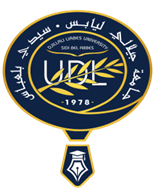Browsing by Author "BELHADJ TAHAR Kamel"
Now showing 1 - 1 of 1
Results Per Page
Sort Options
- ItemContribution a l’étude des impacts anthropiques sur les habitats côtiers de l’Ouest Algérien :approche SIG pour une gestion intégrée de la zone côtière (GISC).(2021-07-18) BELHADJ TAHAR Kamel; Encadreur: KERFOUF Ahmedالملخص (بالعربية) : يهدف العمل الحالي إلى إظهارأهمية استخدام تقنيات نظم المعلومات الجغرافية لتقييم التنوع البيولوجي للحيوانات الساحلية في غرب الجزائر. تتكون قاعدة البيانات المستخدمةمتكونة من المتغيرات الاجتماعية والاقتصادية ، والمتغيرات الأوقيانوغرافية والتكوينية والبيولوجية. تُستخدم تقنيات نظم المعلومات الجغرافية في المرحلة الأولى لرسم خرائط وتحليل التوزيع المكاني لكل معلمة على حدى. ثم يتم تركيب طبقات المعلومات المختلفة لتحديد وحدات التسيير المتجانسة. أظهر الجرد التصنيفي عدم تكافؤ في توزيع المستويات التصنيفية (الفئات والرتب والعائلات والأنواع). 1 فئة و 5 رتب و 23 عائلة و 76 نوعًا من متعدد الأشواك و 3 فئات و 10 رتب و 35 عائلة و 72 نوعًا من القشريات و 3 فئات و 15 رتبة و 19 عائلة و 27 نوعًا من الرخويات و 3 فئات و 5 رتب و 6 عائلات و 10 أنواع من شوكيات الجلد ثم تسمح هذه الدراسة في مرحلة ثانية بإنشاء قاعدة بيانات للأخطار والملوثات في هذا المجال. يتم تحويل قاعدة البيانات التي تم إنتاجها باستخدام نتائج الدراسات المختلفة التي تم إجراؤها إلى بنك ذي مرجع جغرافي. كل خريطة هي نتيجة تجميع للمعلومات المتاحة ، منظمة في قاعدة بيانات تسمح بتكامل النتائج وتراكب المعلومات الجديدة. هذا يشكل وسيلة لتصور التطور الطبيعي للمنطقة ويمكن استخدامها على الفور لتحديد الوضع الحالي للنظام البيئي للمناطق الساحلية بوهران . الكلمات الرئيسية: التنوع البيولوجي ، الجرد الحيواني ، نظم المعلومات الجغرافية ، البنك الجغرافي المرجعي ، خليج وهران . Résumé (en Français) : Le présent travail vise à montrer l’intérêt de l’utilisation des techniques SIG pour l'évaluation de la biodiversité faunistique côtières de l’Ouest algérien. La base de données exploitée se compose de variables socioéconomique, de paramètres océanographiques, édaphiques et biologiques. Les techniques SIG sont utilisées dans une première phase pour la cartographie et l’analyse de la distribution spatiale de chaque paramètre à part. Les différentes couches d’information sont superposées ensuite, pour délimiter des unités de gestion homogènes. L’inventaire taxonomique a montré une inéquitabilité dans la distribution des niveaux taxonomiques (classes, ordres, familles et espèces). 1classes, 5ordres, 23familles et76 espèces de polychètes, 3 classes, 10ordres, 35familles et72 espèces de crustacées , 3classes, 15ordres, 19familles et 27 espèces de mollusques , 3classes, 5ordres, 6familles et 10 espèces d‘ échinodermes. Cette étude permet ensuite dans une deuxième phase la réalisation d’une banque de données des nuisances et polluants dans cette zone. La banque de donnée réalisée en utilisant les résultats des différentes études effectuées, est transformée en banque géo référenciée. Chaque carte est le résultat d’une compilation de l’information disponible, structurée dans une banque de données qui permet d’intégrer des résultats et de superposer les nouvelles informations collectées. Celle-ci forme un moyen de visualiser l’évolution naturelle de la région et est immédiatement utilisable pour la définition de la situation actuelle de l’écosystème des bancs côtiers oranais. Les mots clés : Biodiversité, inventaire faunistique, SIG, banque géoréférenciée, golf d’Oran. Abstract (en Anglais) : abstract : This work aims to show the interest of the use of GIS techniques for the assessment of the coastal fauna biodiversity of western Algeria. The database used is made up of socioeconomic variables, oceanographic, edaphic and biological parameters. GIS techniques are used in a first phase for the mapping and analysis of the spatial distribution of each parameter separately. The different information layers are then superimposed, to define homogeneous management units. The taxonomic inventory showed an inequity in the distribution of taxonomic levels (classes, orders, families and species). 1classes, 5orders, 23families and76 species of polychaetes, 3classes, 10orders, 35families and72 species of crustacea, 3classes, 15orders, 19families and 27 species of molluscs, 3classes, 5orders, 6families and 10 species of echinoderms. This study then allows in a second phase the creation of a database of nuisances and pollutants in this area The database produced using the results of the various studies carried out is transformed into a geo-referenced bank. Each map is the result of a compilation of the information available, structured in a database which allows the integration of results and the superimposition of the new information collected. This forms a means of visualizing the natural evolution of the region and is immediately usable for the definition of the current situation of the ecosystem of the Oran coastal banks. Keywords : Biodiversity, faunistic inventory, GIS, georeferenced bank, Oran gulf .
